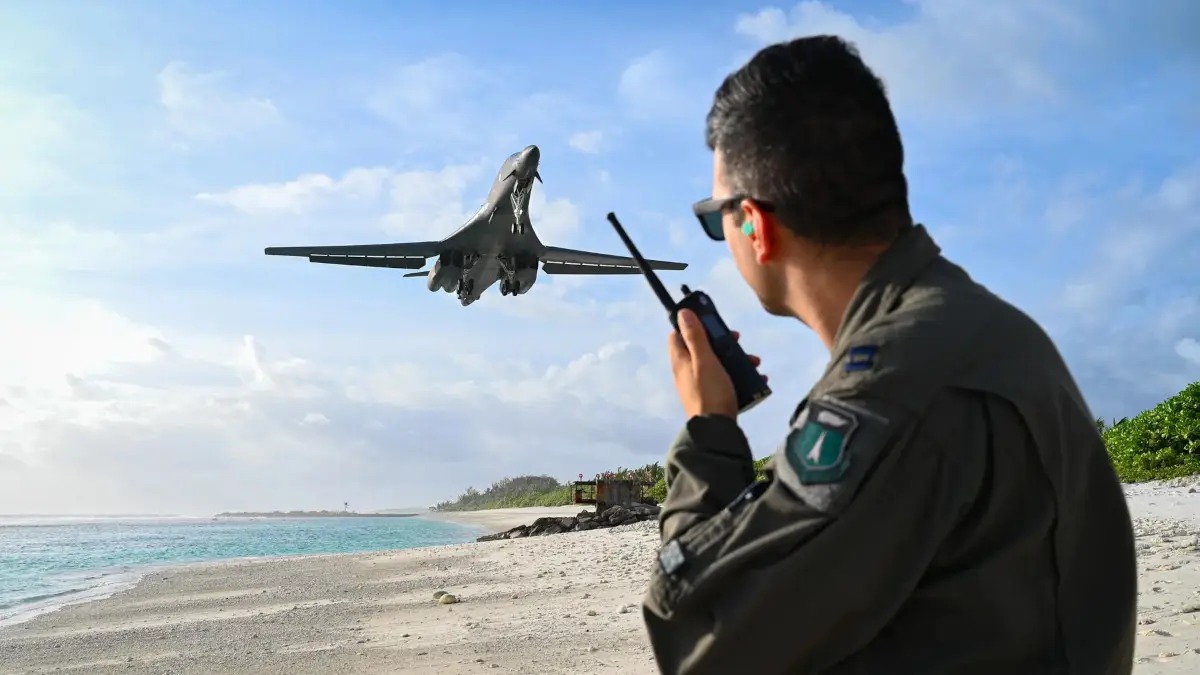US long-range bomber, B-1B, officially called the Lancer but known as “Bone” by its crew, had a rough start to the year when one of the bombers crashed during a training sortie in South Dakota on January 4.
However, the combat veteran aircraft roared again and crossed a continent to pound targets in Iraq and Syria in the airstrikes that the US called “the start of a response.”
The long-range bombers, which flew its first combat mission in 1998 against Iraq, took off from the US to conduct a barrage of airstrikes in Iraq and Syria on Friday, targeting Iran’s Islamic Revolutionary Guard Corps (IRGC), Quds Force and Iranian-backed militia groups.
The retaliatory strikes come a week after a one-way-attack drone struck a remote outpost in Jordan, killing three US Army Reserve soldiers and injuring more than 40 others.
This is the first strike mission carried out by the supersonic strategic bomber ‘Bone’ after it crashed on the runway of Ellsworth Air Force during landing. The Ellsworth B-1 fleet was grounded while the investigation into the crash was ongoing.
The B-1B is one of three heavy bombers in the US Air Force, the other two being B-52H Stratofortress and B-2 Spirit.
In all, 125 precision-guided munitions were launched for 30 minutes over three military facilities in Iraq and four in Syria.
Multiple B-1B platforms participated in the strikes. The facilities that were struck included command and control operations centers, intelligence centers, rockets, missiles, unmanned aerial vehicle storages, and logistics and munition supply chain facilities of militia groups and their IRGC sponsors, who facilitated attacks against US and coalition forces.
The US said that it would refrain from carrying out strikes against targets in Iran’s territory.
The B-1B started as a nuclear strike plane in the Cold War era. It could penetrate Soviet airspace at low altitudes and deliver nuclear payloads. However, after the collapse of the USSR, the aircraft was stripped of its nuclear capability after the fall of the USSR and its arsenal included GPS-guided bombs.
The ‘Bone’ was then used as a high-altitude bomber to pummel the Taliban, Iraqi insurgents, and ISIS. Their endurance allowed them to provide air support for troops.
The Aging B-1B Lancers – ‘Bone To Boneyard’
The USAF intends to retire the Lancers in the 2030s. They will continue to be the force behind the American military punch till they are replaced by the new B-21 stealth bombers.
The Bone debuted in Iraq during Operation Desert Fox in 1998. The swing-wing bomber was a technological marvel at the time, capable of carrying more than two school buses worth of ordnance faster than the speed of sound while occupying less than one percent of the space on an enemy’s radar compared to the B-52 Stratofortress.
They were part of the opening act of the US-led air war in October 2001 in Afghanistan. Five B-1s flew out of its Indian Ocean military airbase of Diego Garcia along with 10 B-52s and two B-2 stealth bombers and pounded the Taliban hideouts. The plane’s instrumental role in decimating the Taliban regime saved it from cuts.
While the USAF cannot use the Bone for its original intended role of low-altitude penetrating strike in the face of modern air defense, its ability to carry heavy payloads (up to 25 tons on its wings or 37.5 tons in its three internal bays) across continents would beg it a prominent role in case a conflict breaks out with Russia or China.
Lancers, in particular, would be used to launch long-range AGIM-158C LRASM anti-ship missiles and possibly lug hypersonic weapons. A single B-1 is said to have the ability to drop as many bombs on Syrian and Iraqi targets as 40 attack jets flying off an aircraft carrier in the Persian Gulf.
Born before stealth technology became mainstream, the Bone relies on radar-reflecting materials and its ability to fly at extremely low altitudes to avoid enemy radars. At low altitudes, most air defense systems cannot distinguish the B-1B from the terrain around it, especially when flying through mountainous terrain.
Even though the USAF plans to replace the Bone with the B-21 Raider (which has just undertaken its first flight), it has launched modernization plans to give the aging fleet a new lease of life.
Switching to BEAST mode
The USAF has launched the B-1 Embracing Agile Scheduling Team (BEAST) program to expeditiously upgrade the B-1B Lancer. The bomber will receive a series of technological upgrades, including a modern Identification Friend or Foe system, Link 16 tactical data communications capability, upgraded secure communications systems, an updated defensive avionics system, and updated mass data storage to handle the large amounts of information flowing through modern battlefields.

The BEAST modifications should give the B-1 life and lethality to 2040 and beyond.
These heavy bombers suffered from a serviceability crisis at one time in 2019, when less than 10 of the 62 bombers could carry out all missions. The problem was so severe that the B-1B crew was assigned to other airframes.
The last of the B-1B Bombers was produced in 1989, and with age, they have been suffering from structural issues. The upgrade program is meant to deal with these issues and keep the Bone fly-worthy till the Raider comes along.
- Ritu Sharma has been a journalist for over a decade, writing on defense, foreign affairs, and nuclear technology.
- She can be reached at ritu.sharma (at) mail.com
- Follow EurAsian Times on Google News